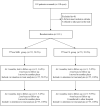Subthreshold Micropulse Laser vs. Conventional Laser for Central Serous Chorioretinopathy: A Randomized Controlled Clinical Trial
- PMID: 34336888
- PMCID: PMC8322653
- DOI: 10.3389/fmed.2021.682264
Subthreshold Micropulse Laser vs. Conventional Laser for Central Serous Chorioretinopathy: A Randomized Controlled Clinical Trial
Abstract
Purpose: To investigate the effectiveness and safety of 577-nm subthreshold micropulse laser (SML) on acute central serous chorioretinopathy (CSC). Methods: One hundred and ten patients with acute CSC were randomized to receive SML or 577-nm conventional laser (CL) treatment. Optical coherence tomography and best-corrected visual acuity (BCVA) were performed before and after treatment. Results: At 3 months, the complete resolution of subretinal fluid (SRF) in 577-nm SML group (72.7%) was lower than that in CL group (89.1%) (Unadjusted RR, 0.82; P = 0.029), but it was 85.5 vs. 92.7% at 6 months (unadjusted RR, 0.92; P = 0.221). The mean LogMAR BCVA significantly improved, and the mean central foveal thickness (CFT) significantly decreased in the SML group and CL group (all P < 0.001) at 6 months. But there was no statistical difference between the two groups (all P > 0.05). In the SML group, obvious retinal pigment epithelium (RPE) damage was shown only in 3.64% at 1 month but 92.7% in the CL group (P < 0.001). Conclusions: Although 577-nm SML has a lower complete absorption of SRF compared with 577-nm CL for acute CSC at 3 months, it is similarly effective as 577-nm CL on improving retinal anatomy and function at 6 months. Importantly, 577-nm SML causes less damage to the retina.
Keywords: central foveal thickness; central serous chorioretinopathy; conventional laser photocoagulation; subretinal fluid; subthreshold micropulse laser.
Copyright © 2021 Zhou, Lai, Jin, Huang, Xu, Gong, Li, Zhu, Lu and Jin.
Conflict of interest statement
The authors declare that the research was conducted in the absence of any commercial or financial relationships that could be construed as a potential conflict of interest.
Figures




References
LinkOut - more resources
Full Text Sources
Miscellaneous

